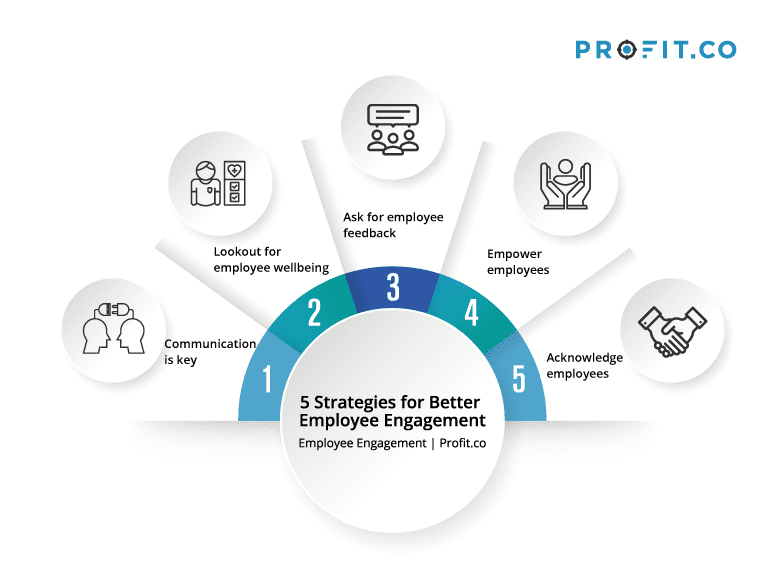The success of an organization is largely dependent on its employees’ happiness, and how engaged they are at the workplace. Which is why it is very important to have clearly defined employee engagement strategies. Well defined employee engagement strategies will help create a good work environment which will boost employee productivity and performance; and as a result will be very beneficial to the organization.
You’ve got to love what you do to really make things happen.
Following are a few employee engagement strategies for an improved workplace:
- Communication is key
- Lookout for their wellbeing
- Ask for employee feedback to make an informed and collective decision
- Empower Employees
- Acknowledge them

1. Communication is key
One of the most important things to keep employees engaged is Communication. It’s the employees who determine the quality of the workplace and the future of the organization, therefore they must be kept updated of what’s happening in the organization. It’s very important that people and departments don’t start working in silos or start getting disconnected from their coworkers.
An internal communication system will help keep employees in the loop with what’s going on in the organization — whether it’s a change in HR policies, new manager in a certain department, a new client or anything else. This could be done digitally or offline — through the company intranet, text messages, posters — choose a medium or more that’s most relevant and that works best.
Employees must feel that they can open up about any issues that they might be facing with the coworkers or managers.
2. Lookout for their wellbeing
An employee experiencing burnout is a very unhappy employee. Take steps to create a healthy workplace. Take care of their wellbeing by taking the following steps:
- Introduce an employee assistance program to assist them with work related or personal issues that may impact
- their physical and emotional well being
- Promote healthy eating and physical fitness
- Train first aid providers for mental health
Take a good look at the organization’s work culture — is there a culture of working late, which could be because of too much work or is it just bad time management? Does the management expect employees to come to work when they should be staying home? — like in the case of a pandemic? Do people come into work on weekends because they weren’t, or didn’t finish work during the week? Are there unrealistic deadlines that employees are expected to meet? Understand how employees are working and then implement a plan to tackle these issues.
Make sure that these changes don’t come across as being authoritative, but rather that it comes from a place of wanting to look out for them. In addition to making these changes,
- Actively listen to the employees.
- Help them out and support employees if they are facing some issues
- Spend some time with them outside the office once in a while and connect with them at a personal level
3. Ask for employee feedback to make an informed and collective decision
An organization that listens to its employees is an organization that’s on the path to success. It makes them feel listened to, and gives them a sense of belonging. They feel they are worth something and that their work matters. When senior management listens to their employees and acts upon their opinions, they put in more effort working towards the organization’s goals.
There are online feedback surveys and other formal feedback channels to get employee feedback. Just make sure to pay heed to their opinions and act on it.
When all the feedback has been collected and collated, organize a team meeting. Discuss the issues that they face, and talk about how it can be solved. When the management pays heed to the employees’ opinions, the more trusted, respected and empowered they will feel which as a result will boost their engagement.
4. Empower Employees
Micromanagement is Employee Engagement’s enemy. Constant correction, negative feedback and having something breathe down your neck can have a very negative impact on employees’ morale and productivity. Work will not progress when there are constant interruptions and it just becomes so suffocating to work in an environment like that.
Instead, hand over the reins to the employees. Understand what the employees’ unique working styles are and let them work independently, and just be around should they need guidance. Don’t stifle them. Help them develop an action plan and encourage them and let them make and learn from their mistakes. This is a recipe for success. When they understand the consequences of their management decisions, they come out more confident, independent and empowered.
5. Acknowledge them
Acknowledge them. Not just their work, but them. The company needs to place its respect and trust in its employees, and in turn it creates an environment full of positivity and enthusiasm. An organization such as this is where great ideas come to life. Where teams of departments thrive together and collaborate, because they all have one single objective in mind — the company’s success.
Foster a culture of openly acknowledging and recognizing good work. Where every employee of the organization encourages each other for work well done. Acknowledgement and appreciation go a long way in boosting employee morale. Just a simple ‘Thank You’ can work wonders for an employee’s morale.
Digital channels, and an incentive based award program are some of the ways that can help facilitate the culture of openly thanking and recognizing each other’s efforts.
Use the intranet or notice boards to let employees know that the management has acted upon the employees’ suggestions and opinions.
In Conclusion
Great employee engagement takes work. It will not happen overnight. It will not show results immediately. It takes effort and consistency and it will slowly start to show results. Employee engagement strategy needs to be customized to suit the organization’s and its employees’ needs. It’s about creating an environment where employees can flourish and grow. It’s a win-win situation for all parties involved.

